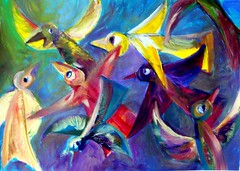Israel - Photos and paintings
Die Lorelei
Die Lorelei is a well-known and often performed German folksong. The words were written by the exceptional German poet Heinrich Heine (1799-1856) and first published 1827 in Buch der Lieder (Book of Songs), his 'most famous collection of lyrics' which were 'chiefly inspired by his unrequited love for his Uncle's daughter, Amalie.' Heine's poetry has 'natural rhythm and melodic charm,' and Die Lorelei 'achieved the simplicity and depth of folk poetry.' The music was composed by Friedrich Silcher (1789-1860), a composer, poet, music teacher, publisher, and choral director noted for his encouragement of German folksong singing. [source]

Emil Krupa-Krupinski: Loreley, 1899

(drawing by Arthur Rackham)
THE LEGEND OF LORELEY
After a legend, a mermaid called Loreley, was sitting on the Rock. She attracted many seamen with her beautiful singing. The seamen were whatching Loreley, while she was combing her golden hair.
Nobody paid attention to the dangerous rock in the water. So many boats were distroyed and the swirl (which was actually up to 27 meters deep), grabbed them. [source]

THE LORELEI
LOUIS WEIRTER, R.B.A. [with a text about the river Rhine legends]

The Loreley around 1900
THE LORELEIMore about the name of Loreley, and references.
I'm looking in vain for the reason,
That I am so sad and distressed;
A tale known for many a season,
Does not allow me to rest.
Cool is the air in the twilight
And quietly flows the Rhine;
The mountain glows with a highlight,
From the evening sun's last shine.
The fairest of maiden's reposing,
So wonderfully up there.
Her golden jewelry disclosing,
She's combing her golden hair.
She combs it with a comb of gold
And meanwhile is singing a song;
A melody strangely bold
And unbelievably strong.
The bargeman in his small craft
Is seized with longings and sighs.
He sees not the rocks fore and aft,
He looks only at her and the skies.
It looks like the waves are flinging,
Both man and boat to their end;
That was what with her singing,
The Lorelei did intend.
Heinrich Heine
Read more...
Fernand Léger - Cubist painter
>> –
painting
Léger's steady intention was to provide art for the people. His ideas and philosophy attracted many students in both Europe and the Americas. He always had a great interest in industrial evolution and its relationship to man. This became one of the central themes of his oeuvre. Léger continually experimented with color, shape, movement, and space. Geometric forms and elements of a machine culture (cranks, pistons, robots, etc.) were important motifs in his many creations.
In 1940, to escape German forces in Paris, Léger fled to the United States. The industrialism found in America heavily inspired his work of this period. [source]cubist fernand legger painting cubism painter
Many worlds of Goya
Francisco de Goya y Lucientes (1746-L828) was one of the most influential figures in Spanish art. He was also extremely important in the development of modern aesthetic sensibility, a forerunner of Romanticism, both in the content of his paintings, with their in-depth exploration of reality and references to the dream world, and in his very original technique.Read more...
David Farrant
David's primary inspiration stems from everyday scenes of human interaction, and he reproduces these against a living background of muted colours and complex shadows, in the hope that they "carry a mood and the possibility of an unfinished story which the viewer can share".
Read more...
Magda Wieclawska - Painting
Life is too full of countless inspiring moments which beg to be captured on canvas or paper. I use oil paints, charcoal as well as acryl and pastels.
The greatest inspiration and challenge, however, is nature: her spectacular presence in every moment of day and night. I try to portray the intangible elements such as the light, the sky, the surf, the silence….
Subscribe to:
Comments (Atom)






































